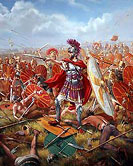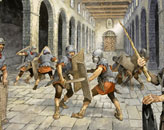|
Early Roman Soldiers
The Roman army was first and for most a heavy infantry army. Strategically
they won and lost pitched battles by their center, their heavy infantry.
When they lost battles it was often due to being out flanked because
of their inferior cavalry. However, when the flanks held the roman
soldier was able to wear down almost any enemy. Eventually this
caused a rout in the center of the opposing army, a catastrophic
battlefield problem. Over the centuries various enemies were able
to exploit this but by in large the strategy of the Roman soldiers
prevailed to such an extent that the Roman Empire was formed.
Roman legionnaires developed through stages as the decades and centuries
progressed, adapting to new enemies and taking from them lessons
about what works in the field of battle. They continually borrowed
effective weaponry of their enemies. The Roman’s took the
strongest Roman weapons, hand, naval
or siege, from their enemies and applied them to their military.
Additionally, they took the best tactics and strategies used against
them and applied them to their playbooks. A valuable lesson was
taught to the Romans by Hannibal during the Second Punic War, bloodily
demonstrating to the Roman generals that greater forces can be destroyed
be greater strategies. Unfortunately for Hannibal, the young Roman
General Scipio Africanus learned the lessons all too well. He had
lost two uncles and his father to Hannibal’s ruses and was
able to turn Hannibal’s tricks against him in the end. All
of this, plus an inestimable force of the Roman peoples renown will,
gave the roman soldiers a great backing and foundation to achieve
victory on the battlefield.
Modern scholars, games and reference books typically like to break
the Roman military into phases. This is a good way to deal with
the subject quickly but obviously the changes were more fluid than
books, games and documentaries may portray. However, for the same
reasons they do it, I will too. Below is a summary of the different
phases of the typical Roman soldier.
Early Republican Roman Soldiers
As Rome emerged from the shadows of the Etruscans to the North that
dominated them they inherited their style of warfare. The Etruscans,
and thus the Romans, modeled their soldiers after the Greek Warriors,
the hoplites. However, the Etruscans fell to invasions from Celtic
Warriors from their North and soon these same warriors were knocking
on Rome’s door. Actually, they did more than just knock and
sacked the city. The Romans took a lesson from this, and as the
Celtic warriors retracted to the formally Etruscan territory to
solidify their gains, the ever adaptive Romans took note of their
fighting style. It is believed that in this area the Romans soldiers
took on their main weapons, a sword and a big body shield. They
had forgone the age old spear and round shield in favor of this
new weaponry, but history is never that simple. They also engaged
in a century long war against the hill peoples that were their neighbors.
These Samnites preferred a more gorilla type warfare, and after
several humiliating defeats of Roman armies the Roman soldiers once
again adapted. They devised a looser formation, like the Samnites,
and hence gained a tactical mobility that hoplite lines can’t
compete with. It is also believed that they developed their heavy
javelins, or pila, at this time due to Samnite influence (See Roman
Weapons).
Late Republican and Early Empire Roman Soldiers
The Roman soldiers never got a lot of rest at this time in history
and rapidly on the heels of their mastery of central Italy came
wars against Pyrrus (a Greek/Macedonian king), Carthage and Macedonia
itself, punctuated by Germanic and Celtic invasions from the North.
The hard pressed Romans rose to the occasion, it could be called
their finest hour if it didn’t last for another century. In
order to survive the Romans had to win battles and they did this
with their adaptable Roman soldiers. It is at this time that the
classic Roman legionary was created. The Roman soldier was equipped
with elements of the foes he had defeated. Great generals like Marius
and Caesar perfected both Roman strategy and tactics at this time,
while greatly expanding the Roman Empire in general. The Roman soldiers
became professional soldiers, not allowed even to marry, they were
to be the first mass professional army and they performed in the
roll admirably.
This is the time that the classic roman weapons took root. Each
soldier flung two heavy javelins at their enemy before closing ranks.
The common Roman soldier was better armored than their opponents
and after the devastating volley of heavy javelins (pila) they got
down to the ugly business of killing men one on one. They defended
themselves with body shields, like they learned from the Celtic
Warriors, and even copied their chainmail and helmets, this enabled
them to get in close and finish off their opponents their short
swords. These short swords were another borrowed invention, this
time from the Celts, Celtiberians and Iberians of what is now modern
Spain. The Romans, ever the masters of borrowing whatever worked
from their enemies did come up with an original idea however, they
crafted excellent plated armor and the Romans being eternally practical
fashioned their armor so it could be collapsed for transportation.
However, the greater genius of the Roman military was its ability
to borrow these weapons, armor and tactics and form them into the
most efficient manner. The Romans were above all organized, at least
militarily. It was at this time and with these weapons that Rome
became the empire that we think of today, conquering Gual, Britain,
Egypt, Greece, Macedonia, Pontus, Syria, Palestine and more.
Late Roman Soldiers
The Roman army once again was forced to adapt to new enemies during
the third century AD. The once unstoppable Roman soldiers had met
their match, been ground down or been internally weekend. It looked
as though the Roman Empire would fall, but through momentum and
resilience it was able to survive for at least three hundred more
years (depending on the date you pick for its demise, the Eastern
Roman Empire survived for another 1200 years!). Regardless, the
late Roman soldiers were forced to adapt to new enemies and strategic
situations, and once again they rose to the challenge.
Strategically the frontiers of the Roman Empire were made to be
less static, with weaker border guards backed by large regional
field armies. While these border guards can be considered just a
step above local militia, the field armies were a different story.
More money was put into professional soldiers, both highly skilled
cavalry (the beginnings of European knights) and missile troops.
These missile troops consisted of archers and some much more exciting
soldiers who operated awesome ballista’s like the “scorpion”.
These were essentially large, mounted crossbows capable of highly
accurate, rapid fire and able to penetrate multiple people. Plus
they were transportable enough to make it to the battlefield, making
them an early example of battlefield artillery.
The heavy Roman soldier remained as deadly as ever during this period
however, perhaps even more deadly. This is despite being from a
more fractured political system and even being a smaller proportion
of the military than during the imperial period. They continued
to employ similar tactics although they developed larger round shields
and longer swords, perhaps as a defense against cavalry threats
or perhaps due to the influence of the ever increasing number of
“barbarians” in the army. One exciting advancement in
the area of Roman soldiers was the Plumbata, a weapon that enabled
them to act as their own missle troops. This amazing weapon was
what can be described as an oversized lawn-dart pushed through an
oblong led ball. This weapon was attached to a leather cord and
whipped around like a sling to gain range, ancient writers report
it had the range of a bow (around 200 yards). The plumbata would
then crash down into enemy formations killing the guy unlucky enough
to be in its trajectory.
Late Roman military expenditures greatly skewed towards cavalry
than previously, due to horrible experiences with peoples like the
Huns. Mounted archers became highly valued to counter the threats
posed by enemy mounted archers, but the development of the stirrups
is often credited with causing more long term changes in military
history. With stirrups a lancer is able to lean his wait into a
charge, not just the muscles of his arms, and if he is rigid enough
he can transfer the force of his mount into a blow. This intern
lead to the development of the heavy cavalry, a man and horse fully
armored with a lance that would evolve into the knight due to the
great expenses of equipping such soldiers and the fracturing of
the political system.
At the same time as all of this was happening a destabilizing fact
was occurring throughout the period, the Roman army was becoming
more and more “barbarian”. By this it is meant that
the common Roman soldier less and less owed his allegiance to Rome,
but to a tribe the Romans considered to be barbarians. As the Roman
armies became filled with Germans, and many other ethnicities, their
loyalties to the empire became opportunistic. For many reasons,
several hundred creditable ones have been proposed, the Western
Roman Empire, and its soldiers, could no longer hold its borders.
In the end the Roman soldiers had been the dominate force in the
Western half of Eurasia for 1000 years and they would continue on
in the Eastern half of the Mediterranean for another 1000 more.
With this record the Roman soldier deserves to be recognized as
one of the most successful in history.
.
|


